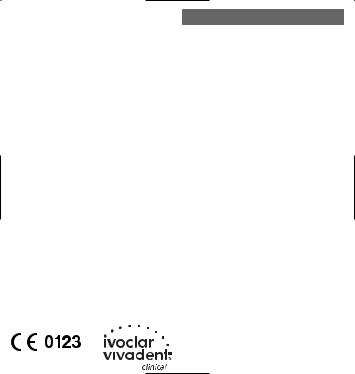Ivoclar Vivadent Heliobond User Manual v.1 [en, de, fr, it, es]

 Heliobond
Heliobond
Instructions for Use
Gebrauchsinformation
Mode d’emploi
Istruzioni d’uso
Instrucciones de uso
Instruções de Uso
Bruksanvisning
Brugsanvisning
Käyttöohjeet
Bruksanvisning
Productinformatie
Oδηγίες Xρήσεως
–Light-curing primer agent
–Lichthärtender Haftvermittler
–Agent de liaison photopolymérisable
–Promotore di adesione fotoindurente
–Adhesivo fotopolimerizable
–Adesivo fotopolimerizável
–Ljushärdande bonding resin
–Lyshærdende resin
–Valokovetteinen sidosresiini
–Lichtuithardend hechtmiddel
–Φωτ π λυμερι μενη υγρή ρητίνη
594771/1105/WE3/H
English
Instructions for Use
Description
Light-curing, single-component bonding material (bonding liquid) for optimizing the enamel etching technique in combination with all light-curing restorative materials (Heliomolar®, Helio Progress®, Tetric®,
Tetric EvoCeram®)
Composition |
|
Heliobond contains: |
|
Bis-GMA |
60 %wt. |
Triethylene glycol dimethacrylate |
40 %wt. |
Indication
–Bonding agent (bonding liquid) for adhesive restorations
–Transparent sealant for fissures and restorations
–Bonding layer for the repair of resin-, crown-, or bridge works
Contraindication
Heliobond should not be used if patients are known to be allergic to any of the ingredients.
Other interactions
To achieve an optimum bond to the enamel, the enamel etching technique (e.g. with Total Etch) has to be applied. Contamination of the etched and dried enamel surface with saliva or blood hampers this effect. Phenolic substances (e.g. eugenol) inhibit polymerization. The use of base materials containing these substances is thus contra-indicated.
Application
Preparation of enamel
–Depending on the case, bevel enamel surfaces to be treated with a diamond or clean them carefully with an abrasive (e.g. pumice powder and water). Do not use any oily or greasy paste. Possible residue of base

materials on the enamel are removed in that way. Then, rinse and dry.
–Apply Total Etch on the enamel surfaces to be treated and allow it to react. After that, carefully rinse with water spray and dry the etched surfaces with an air blower (use only waterand oil-free air).
–The area of application must be kept dry, e.g. with cotton rolls. For difficult working situations, we recommend isolation with a rubber dam.
–The etched and dried enamel surface must not be contaminated prior to the application of Heliobond (if the surface comes in contact with saliva or blood, the etching and drying procedures must be repeated).
Dosage
–Dosage depends on the indication. When used as a bonding agent (bonding liquid), a very thin layer of Heliobond has to be applied. If necessary, use an air blower to achieve an optimally thin layer.
–When used as a transparent fissure sealant, however, Heliobond must be applied in thicker layers.
Method of application
1. Bonding agent for adhesive restorations
–Etch desired enamel surfaces (see preparation of the enamel). If necessary, cover exposed dentin surfaces with Syntac® dentin bonding agent (see Instructions for Use of Syntac).
–Apply a thin layer of Heliobond with a brush, a spherical instrument, or by means of the attachable cannula on the etched enamel surface.
–You can achieve an optimally thin layer with an air blower.
–If used in combination with light-curing composites, Heliobond does not require separate polymerization. When working on freely modelled restorations, however, we recommend separate polymerization of Heliobond for 10 s (bluephase®).
–Application of the composite
–Polymerization of the composite
–Finishing of the restoration
2. Transparent sealant for fissures and pits
–Etch desired enamel surfaces (see preparation of the enamel).
–Apply Heliobond with a suitable instrument, a brush, or by means of the attachable cannula into the fissures. Avoid entrapment of air.
–Polymerize with light for 20 s (bluephase®).
–After curing, remove inhibited layer. Check occlusion and grind off any excess material.
3. Preparation of resin repair works
–Roughen the smooth resin surfaces.
–If necessary, apply Monobond S (see Instructions for Use of Monobond S).
–Apply a thin layer of Heliobond (use an air blower, if necessary).
–Polymerize with light for 10 s (bluephase®).
Polymerization
–10 s polymerization time is sufficient for thin layers (bluephase®).
–Thicker layers (e.g. sealings) require 20 s curing time (bluephase®)
–The light probe should be held less than 5 mm above the Heliobond surface, but it should not touch unpolymerized material
Note
–Do not expose Heliobond to intensive light during application, as this significantly shortens the working time.
–If Heliobond is used as covering layer (e.g. as a sealant), a thin layer of unpolymerized, sticky material will remain on the surface after polymerization, due to oxygen inhibition. We recommend removing this layer with cotton rolls or pellets.
Storage
–Close bottle immediately after use. Exposure to light may lead to premature polymerization.
–Storage: 2–28 °C / 36–82 °F

–Do not use Heliobond after the dat of expiration
–Date of expiration: See note on the bottle/ packaging
Warning
Avoid contact of Heliobond with the skin/mucous membrane, or eyes. Unpolymerized Heliobond may cause slight, reversible irritation, or lead to a general sensitisation against methacrylates.
Keep material out of the reach of children! For use in dentistry only!
Date information prepared: 10/2005
Manufacturer
Ivoclar Vivadent AG, FL-9494 Schaan / Liechtenstein
This material has been developed solely for use in dentistry. Processing should be carried out strictly according to the Instructions for Use. Liability cannot be accepted for damages resulting from failure to observe the Instructions or the stipulated area of application. The user is responsible for testing the material for its suitability and use for any purpose not explicitly stated in the Instructions. Descriptions and data constitute no warranty of attributes and are not binding.
 Heliobond
Heliobond
Deutsch
Gebrauchsinformation
Beschreibung:
Lichthärtender Einkomponenten-Haftvermittler (Bonding Liquid) zur Optimierung der Schmelzätztechnik mit allen lichthärtenden Füllungswerkstoffen (z.B. Heliomolar®, Helio Progress®, Tetric®, Tetric EvoCeram®).
Zusammensetzung: |
|
Heliobond enthält: |
|
Bis-GMA |
60 Gew.% |
Triethylenglycoldimethacrylat |
40 Gew.% |
Indikation:
–Als Haftvermittler (Bonding Liquid) für die adhäsive Restauration
–Transparente Versiegelung von Fissuren und Füllungen
–Als Haftschicht bei der Reparatur von Kunststoff-, Kronenund Brückenarbeiten
Kontraindikation
Bei bekannter Allergie auf einen der Inhaltsstoffe, ist auf die Anwendung von Heliobond zu verzichten.
Wechselwirkungen:
Zur Erzielung einer ausreichenden Haftung am Schmelz muss die Säureätztechnik (z.B. mit Total Etch) angewendet werden. Eine Kontamination des geätzten und getrockneten Schmelzes z.B. mit Speichel oder Blut hebt diese Wirkung auf. Phenolische Substanzen (z.B. Eugenol) inhibieren die Polymerisation – daher keine derartige Substanzen enthaltende Unterfüllungsmaterialien verwenden.

Anwendung:
Schmelzvorbereitung
–Je nach Fall die zu behandelnden Schmelzflächen mit einem Diamanten anschrägen oder mit Abrasiv, z.B. Bimsmehl und Wasser sorgfältig reinigen (keine ölund fetthaltigen Abrasiv-Pasten verwenden). Eventuell auf dem Schmelz befindliche Unterfüllungsüberschüsse sollen hierbei entfernt werden. Anschliessend spülen und trocknen.
–Total Etch auf die zu behandelnden Schmelzflächen auftragen und einwirken lassen. Anschliessend sorgfältig mit Wasserspray spülen und die geätzten Flächen mit Luftbläser sorgfältig trocknen (nur trockene, ölfreie Luft verwenden).
–Der Applikationsbereich muss trocken gehalten werden z.B. mit Watterollen. Bei schwierigen Arbeiten empfiehlt sich die Verwendung von Kofferdam.
–Die geätzte trockene Schmelzoberfläche darf vor der Heliobond-Applikation nicht kontaminiert werden (bei Speicheloder Blutkontakt muss erneut geätzt und getrocknet werden).
Dosierung:
–Die Dosierung ist vom Anwendungsgebiet abhängig. Bei der Verwendung als Haftvermittler (Bonding Liquid) soll eine möglichst dünne Haftschicht erzielt werden. Gegebenenfalls kann durch Abblasen mit dem Luftbläser eine optimal dünne Schicht erreicht werden.
–Dagegen erfordern transparente Versiegelungen von Fissuren dickere Schichten von Heliobond.
Art der Anwendung:
1.Als Haftvermittler für die adhäsive Restauration
–Gewünschte Schmelzflächen anätzen (siehe Schmelzvorbereitung), evtl. freiliegende Dentinflächen mit Syntac® Dentinhaftvermittler vorbehandeln (siehe Gebrauchsinformation Syntac).
–Heliobond mit einem Pinsel, einem Kugelinstrument oder mit Hilfe der aufsteckbaren Plastikkanüle in dünner Schicht auf die geätzte Schmelzfläche auftragen.
–Durch Abblasen mit dem Luftbläser kann eine optimale, dünne Schicht erreicht werden.
–Heliobond muss in Verbindung mit lichthärtenden Composites nicht separat ausgehärtet werden. Bei freier Modellierung von Restaurationen ist die vorherige Härtung von Heliobond vorteilhaft: Belichtungszeit 10 sec. (bluephase®).
–Einbringen des Composites
–Aushärtung des Composites
–Ausarbeiten der Füllung
2.Transparente Versiegelung von Fissuren und Grübchen
–Gewünschte Schmelzflächen anätzen (siehe Schmelzvorbereitung).
–Heliobond mit geeigneten Instrumenten, Pinseln oder mit Hilfe der aufsteckbaren Plastikkanüle blasenfrei in die Fissuren applizieren.
–Aushärten mit Licht (bluephase®, 20 sec.)
–Nach Aushärtung inhibierte Schicht abtupfen. Okklusion prüfen und eventuellen Überstand einschleifen.
3. Vorbereitung von Kunststoff-Reparaturen
–Glatte Kunststoff-Oberflächen aufrauhen
–Gegebenenfalls Monobond-S verwenden (siehe Gebrauchsinformation bzw. Monobond-S)
–Heliobond dünn auftragen (gegebenenfalls Abblasen mit Luftbläser)
–Heliobond aushärten (bluephase®, 10 sec.)
Aushärten:
–Bei dünnen Schichten ist eine Belichtungszeit von 10 sec. (bluephase®) ausreichend.
–Bei dickeren Schichten (z.B. Versiegelung) sollte 20 sec. (bluephase®) belichtet werden.
–Abstand des Lichtleiters von der HeliobondOberfläche möglichst gering (kleiner als 5 mm) halten, jedoch ohne Berührung der ungehärteten Oberfläche.

Besondere Hinweise:
–Heliobond während der Applikation nicht intensiver Beleuchtung aussetzen, da die Verarbeitungszeiten dadurch stark verkürzt sind.
–Wird Heliobond als Deckschicht (z.B. Versiegelung) verwendet, bleibt durch die Sauerstoffinhibierung eine geringe, unpolymerisierte, klebrige Oberflächenschicht zurück. Es wird empfohlen, die inhibierte Schicht mit Watterollen oder Wattepellets abzuwischen.
Lagerund Aufbewahrungshinweise:
–Fläschchen nach Gebrauch sofort verschliessen, Lichtzufuhr führt zu vorzeitiger Polymerisation.
–Lagertemperatur: 2–28 °C
–Heliobond nach Ablauf des Verfalldatums nicht mehr verwenden.
–Ablauffrist: Siehe Hinweis auf Fläschchen/ Verpackung.
Warnhinweis:
Kontakt von Heliobond mit Haut/Schleimhaut oder Augen vermeiden. Heliobond kann in unausgehärtetem Zustand eine leichte, reversible Reizung auslösen sowie zu einer allgemeinen Sensibilisierung auf Methacrylate führen.
Für Kinder unzugänglich aufbewahren!
Nur für zahnärztlichen Gebrauch!
Erstellungsdatum der Gebrauchsinformation:
10/2005
Hersteller:
Ivoclar Vivadent AG, FL-9494 Schaan / Liechtenstein
Das Produkt wurde für den Einsatz im Dentalbereich entwickelt und muss gemäss Gebrauchsinformation verarbeitet werden. Für Schäden, die sich aus anderweitiger Verwendung oder nicht sachgemässer Verarbeitung ergeben, übernimmt der Hersteller keine Haftung. Darüber hinaus ist der Verwender verpflichtet, das Material eigenverantwortlich vor dessen Einsatz auf Eignung und Verwendungsmöglichkeit für die vorgesehenen Zwecke zu prüfen, zumal wenn diese Zwecke nicht in der Gebrauchsinformation aufgeführt sind.
 Heliobond
Heliobond
Français
Mode d‘emploi
Définition
Agent de liaison monocomposant photopolymérisable (Bonding liquide), pour l’optimisation du joint périphérique des obturations réalisées dans le cadre de la technique de mordançage. Heliobond peut être utilisé avec tous les composites photosensibles (par exemple Heliomolar®, Helio Progress®, Tetric®, Tetric EvoCeram®).
Composition |
|
1 g Heliobond contient: |
|
Bis-GMA |
60 %poids |
Triéthylèneglycole diméthacrylate |
40 %poids |
Indications
–Agent de liaison pour collages (Bonding liquide)
–Scellement invisible des puits et sillons
–Couche adhésive nécessaire pour la réparation de couronnes et bridges composites
Contre-indications
En cas d’allergie connue à l’un des composants, ne pas utiliser Heliobond.
Interactions
Le mordançage de l’émail (par ex. avec Total Etch) améliore la rétention. La contamination de l’émail mordancé et séché, par exemple par la salive ou le sang, annule cette action. Les substances à base de phénol, telles que l’eugénol par exemple, inhibent la polymérisation. De ce fait, ne pas utiliser de fond de cavité contenant de telles substances.

Mise en oeuvre
Préparation de l’émail
–Selon la surface amélaire à préparer, biseauter avec un diamant ou la nettoyer soigneusement avec une poudre abrasive (p. ex. de ponce) et de l’eau (ne pas utiliser d’huile ou de pâte abrasive à base de corps gras). Eliminer en même temps les excédents éventuels du fond de cavité sur l’émail, puis rincer et sécher.
–Appliquer Total Etch sur la zone à mordancer et laisser agir. Rincer ensuite sous spray et sécher à la soufflette (n’utiliser que de l’air sec, exempt d’huile).
–La zone d’application doit être préservée de l’humidité à l’aide de rouleaux de coton. Dans le cas de travaux délicats, il est recommandé d’utiliser une digue.
–La surface mordancée et séchée de l’émail ne doit pas être contaminée par la salive ou le sang avant l’application d’Heliobond. Le cas échéant, mordancer et sécher à nouveau.
Dosage
–Le dosage varie suivant le domaine d’application. Utilisé comme agent de liaison (Bonding liquide), appliquer Heliobond en couche fine. Le cas échéant, étaler le matériau à la soufflette pour obtenir une couche fine.
–Quant à l’obturation invisible des fissures, elle nécessite l’application d’Heliobond en couches épaisses.
Application
1. Agent de liaison pour collages
–Mordancer la zone d’application (voir préparation de l’émail) et préparer éventuellement la surface dentinaire mise à nu avec l’adhésif amélo-dentinaire Syntac® (voir mode d’emploi Syntac).
–Appliquer Heliobond en couche fine sur l’émail mordancé, à l’aide d’un pinceau, d’un instrument à boule ou d’une canule en plastique.
–L’étalement du matériau à la soufflette permet d’obtenir une couche fine.
–En liaison avec des composites photopolymérisables, Heliobond ne doit pas être polymérisé séparément. Par contre, pour certains modelages plus élaborés, il peut être avantageux de polymériser préalablement la couche d’Heliobond pendant 10 secondes (bluephase®).
–Application du composite
–Polymérisation du composite
–Finition de l’obturation
2. Scellement invisible des puits et sillons
–Mordancer la zone d’application (voir préparation de l’émail)
–Appliquer Heliobond dans les fissures à l’aide d’un instrument approprié, d’un pinceau ou d’une canule en plastique.
–Polymériser pendant 20 secondes.
–Après durcissement, tamponner la couche inhibée. Vérifier l’occlusion et meuler le surplus éventuel.
3. Préparation des réparations en résine
–Rendre rugueuse la surface du composite
–Utiliser le cas échéant Monobond-S (voir mode d’emploi Monobond-S)
–Appliquer Heliobond en couche fine (si nécessaire, étaler à la soufflette)
–Polymériser Heliobond pendant 10 secondes (bluephase®)
Polymérisation
–Pour le durcissement de couches fines, polymériser pendant 10 secondes (bluephase®).
–Pour le durcissement de couches épaisses (p. ex. scellement), polymériser pendant 20 secondes (bluephase®).
–La distance entre l’embout lumineux et la surface Heliobond doit être aussi petite que possible (inférieure à 5 mm), sans contact avec cette dernière.
Recommandations
–Ne pas soumettre Heliobond à un rayonnement intensif pendant l’application, ce qui réduirait

considérablement les délais de mise en oeuvre d’Heliobond.
–Employé en couverture (par ex. scellement de sillons), il reste après polymérisation une fine couche d’Heliobond inhibée par l’air qui ne durcit pas. Eliminer cette couche collante avec un rouleau ou une boulette de coton.
Conditions de stockage
–Reboucher le flacon aussitôt après utilisation, car tout rayonnement lumineux provoque la polymérisation du matériau.
–Conservée à une température de 2–28 °C
–Date de péremption: cf. indications portées sur le flacon/l’emballage.
Précautions d’emploi
Ne pas mettre Heliobond en contact avec la peau, les muqueuses ou les yeux. Le matériau non parfaitement durcit peut provoquer une légère irritation passagère et une sensibilité au méthacrylate.
Ne pas laisser à la portée des enfants.
Réservé à l’usage professionnel.
Date du mode d’emploi: 10/2005
Fabricant
Ivoclar Vivadent AG, FL-9494 Schaan / Liechtenstein
Ce matériau a été développé en vue d’une utilisation dans le domaine dentaire et doit être mis en oeuvre selon le mode d’emploi. Les dommages résultant du non-respect de ces prescriptions ou d’une utilisation à d’autres fins que celles indiquées n’engagent pas la responsabilité du fabricant. L’utilisateur est tenu de vérifier sous sa propre responsabilité l’appropriation du matériau à l’utilisation prévue et ce d’autant plus si celle-ci n’est pas citée dans le mode d’emploi.
 Heliobond
Heliobond
Italiano
Istruzioni d’uso
Definizione
Bonding monocomponente e fotoindurente per l’ottimizzazione della tecnica di mordenzatura dello smalto con tutti i materiali da restauro fotoindurenti (p.e. Tetric®, Tetric EvoCeram®, Heliomolar®, Helio Progress®).
Composizione |
|
1 g Heliobond contiene: |
|
Bis-GMA |
60 peso% |
Trietileneglicoldimetacrilato |
40 peso% |
Indicazioni
–Quale bonding nella tecnica adesiva
–Sigillatura trasparente di fessure ed otturazioni
–Quale strato di adesione nella riparazione di ponti e corone in resina
Controindicazioni
In caso di allergia nota ad uno dei componenti, evitare l’uso di Heliobond.
Interazioni
Per ottenere una sufficiente adesione allo smalto è necessario l’impiego della tecnica di mordenzatura con acido (p.e. Total Etch). Una contaminazione con saliva o sangue della superficie mordenzata ed asciutta ne annulla l’effetto. Sostanze fenoliche (p.e. eugenolo) inibiscono la polimerizzazione, quindi evitare l’uso di materiali da sottofondo contenenti tali sostanze.
Preparazione dello smalto
–A seconda del caso, rifinire la superficie dello smalto da trattare con diamantata o detergere accuratamente con abrasivi, p.e. pomice ed acqua

(non utilizzare paste abrasive contenenti olii o sostanze grasse). Rimuovere eventuali eccedenze di sottofondo presenti sullo smalto. Infine s ciacquare ed asciugare.
–Applicare Total Etch sulle superfici di smalto da trattare e lasciare agire. Quindi sciacquare accuratamente con spray-acqua ed asciugare accuratamente con getto d’aria le superfici mordenzate (utilizzare solo aria asciutta, priva di olio).
–Il campo operativo deve rimanere asciutto (p.e. con diga o rulli salivari). In caso di lavori estesi è comunque consigliato l’uso di una diga.
–La superficie smalto dentinale mordenzata ed asciutta non deve essere contaminata prima dell’applicazione di Heliobond (in caso di contatto con sangue o saliva necessario mordenzare ed asciugare la parte nuovamente).
Dosaggio
–Il dosaggio dipende dalle indicazioni. In caso di utilizzo come bonding è necessaria l’applicazione in strato molto sottile, ottenibile eventualmente mediante distribuzione uniforme con getto d’aria.
–Sigillature trasparenti di fessure invece richiedono strati più spessi di Heliobond.
Tipo di impiego
1. Quale legante per la tecnica adesiva
–Mordenzare le superfici di smalto da trattare (vedi preparazione dello smalto), pretrattare con l’adesivo dentinale Syntac® eventuali superfici di dentina scoperta (vedi istruzioni d’uso Syntac).
–Applicare Heliobond con un pennello, uno strumento a pallina o con le rispettive cannule d’applicazione sulla superficie di smalto mordenzato.
–Con getto d’aria è possibile una distribuzione uniforme, a strato sottile ottimale.
–In combinazione con compositi fotoindurenti non è necessaria una polimerizzazione separata di Heliobond, comunque è preferibile una fotopolimerizzazione di Heliobond di 10 sec. (bluephase®).
–Applicazione del composito
–Polimerizzazione del composito
–Rifinitura e lucidatura del restauro
2. Sigillatura trasparente di fessure e solchi
–Mordenzare le superfici di smalto da trattare (vedi preparazione dello smalto)
–Applicare Heliobond con strumento idoneo, pennello o con cannula nelle fessure facendo attenzione a non formare bolle.
–Fotopolimerizzare per 20 sec. (bluephase®).
–Al termine della polimerizzazione rimuovere cautamente lo strato inibito. Controllare l’occlusione ed eventualmente rimuovere le eccedenze mediante fresaggio.
3.Preparazione di riparazioni su manufatti in resina (ponti e corone)
–Irruvidire la superficie della resina
–Usare eventualmente Monobond-S (vedi istruzioni d’uso Monobond-S)
–Applicare Heliobond in strato sottile (eventualmente distribuire con getto d’aria).
–Fotopolimerizzare Heliobond 10 sec. (bluephase®)
Fotopolimerizzazione
–In caso di strati sottili è sufficiente un tempo di esposizione di 10 sec. (bluephase®).
–In caso di strati più spessi (p.e. sigillatura) è necessario un tempo di esposizione di 20 sec.
–Mantenere possibilmente una distanza minima dalla superficie di Heliobond (inferiore a 5 mm), evitando però un contatto diretto con la superficie da polimerizzare.
Note particolari per la lavorazione
–Durante l’applicazione non esporre Heliobond a luce intensa, poichè si riduce notevolmente il tempo di lavorazione.
–Nell’uso di Heliobond come strato coprente (p.e. sigillatura), in seguito all’inibizione da ossigeno rimane uno strato superficiale sottile non
